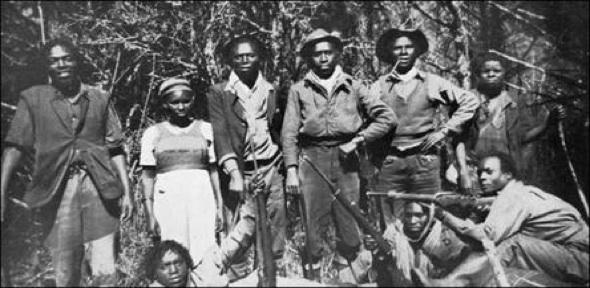The treatment of the Mau Mau by the British has led to compensation claims in the courts. Last year the British government agreed to pay out £19.9m in costs and compensation to more than 5,000 elderly Kenyans who suffered torture and abuse during the Mau Mau uprising in the 50s. Two of those involved in the recent case were women and further female compensation cases are pending.
Gates Cambridge Scholar Katherine Bruce-Lockhart is interested in the treatment of "hardcore" Mau Mau women in the final years of the Emergency Period marked by uncertainty, violence and an increasing reliance on ethno-psychiatry. From 1954 to 1960, the British detained approximately 8,000 women under the Emergency Powers imposed to combat the Mau Mau Rebellion in Kenya. The majority of female detainees were held in Kamiti Detention Camp but new documentary evidence released from the Hanslope Park Archive since 2011 has revealed the existence of a second camp established for women at Gitamayu, created in 1958 in order to deal with the remaining “hardcore” female detainees.

Image credit: University of Cambridge
The Archive contains over 1,500 files and was uncovered in 2011 by historians working on the London High Court case between the British Foreign and Commonwealth Office and Kenyan plaintiffs who were held in detention camps during the Emergency Period. The files were considered too sensitive to fall into the hands of the Kenyan government, and were taken out of Kenya by the British prior to independence and have since been pivotal in the London High Court Case, as their contents show how senior British officials sanctioned the use of systematic force against Mau Mau detainees in the camps, stretching the legal limits of legitimate violence.
The documents relating to Kamiti and Gitamayu reveal how this systematic use of violence was extended to hardcore women and the multiple ways colonial officials tried to hide it. The intensity of this struggle with hardcore detainees, and the trajectory it took, has been overlooked by previous scholarly works on Mau Mau women, which have provided a general overview of female involvement in the movement, as well as their detention at Kamiti.
Much more is known about hardcore men, who have authored over a dozen Mau Mau memoirs and are the subject of extensive scholarly analysis and the hardcore male camps are remembered as the sites of intense struggles between detainees and warders in which the British policy toward hardcore males became more brutal and systematic from 1957 onwards.
The story of the female detainees at Gitamayu and Kamiti reveals unique elements that were determined by colonial ideas about female deviancy, these ultimately becoming the defining feature of incarceration for Mau Mau's hardcore women.
"The Hanslope archives reveal the strategies that the colonial administration employed to deal with hardcore women in the late 1950s. Whereas previously there was an assumption that women were malleable and could be easily persuaded away from the Mau Mau cause this expectation greatly diminished during this time, and was replaced with a discourse of madness, as certain elements of the colonial administration pressed for hardcore women to be classified as insane. This move was instrumental rather than genuine, meant to explain away women's physical ailments in order to cover up mistreatment in the camp," says Bruce-Lockhart.
"Debates about how to deal with this group of women engaged and perplexed the highest levels of the colonial administration, generating tensions between legal, political, and medical officials. At the center of these debates was the question of the female detainees' sanity, with some officials pressing for these women to be classified as insane. Examining the British approach to these detainees illuminates how ideas about gender, deviancy, and mental health shaped colonial practices of punishment."
Citation: Katherine Bruce-Lockhart, '“Unsound” minds and broken bodies: the detention of “hardcore” Mau Mau women at Kamiti and Gitamayu Detention Camps in Kenya, 1954–1960', Journal of Eastern African Studies DOI:10.1080/17531055.2014.948148. Source: University of Cambridge.





Comments